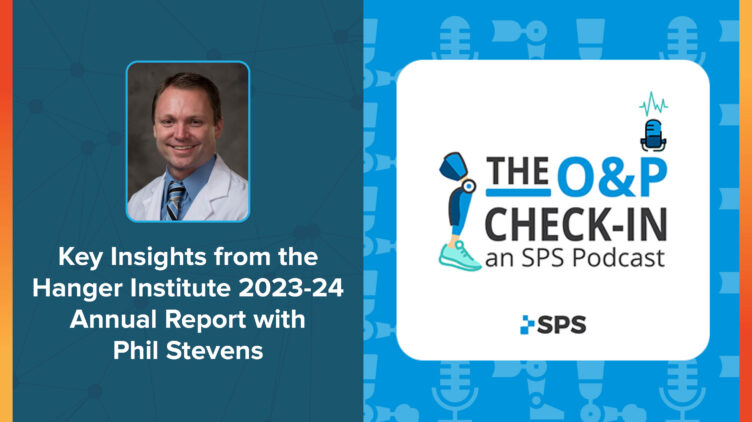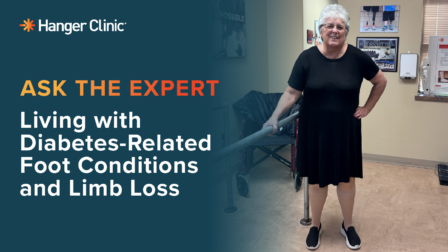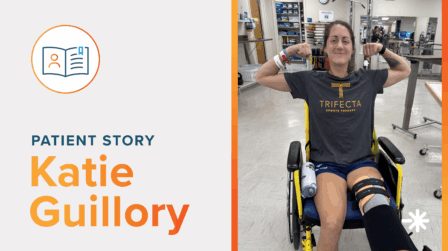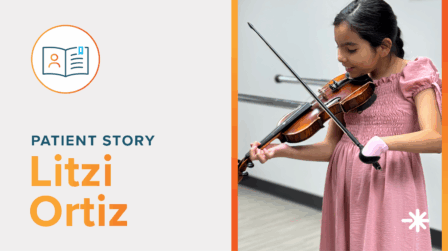Exploring Innovations in Orthotic and Prosthetic Research: Insights from the Hanger Institute Annual Report

The Hanger Institute is dedicated to advancing research that enhances patient outcomes and accessibility to cutting-edge technologies. In the latest edition of The O&P Check-In podcast, Hanger’s Vice President of Clinical Affairs Phil Stevens, MEd, CPO, FAAOP, recaps the Hanger Institute for Clinical Research & Education’s 2023-24 Annual Report and shares his insights on several groundbreaking studies that are helping to shape the future of orthotic and prosthetic care.
Listen to The O&P Check-In Podcast
Hear from Phil Stevens and discover impactful takeaways from the Annual Report that you can use to improve patient outcomes.

CASTLE Study: Setting Benchmarks for Mobility
Similar to growth charts used in pediatric medicine for head circumference and weight, CASTLE establishes benchmarks for lower limb prosthetic mobility based on extensive data collected from tens of thousands of patients. Based on a patient’s amputation level, etiology, and age, the clinician has a good idea of where the patient’s prosthetic mobility should be by referencing the mobility curves that resulted from CASTLE. This allows the clinicians and patients to have meaningful conversations and understand how they function relative to their peers.
When it comes to componentry, microprocessor knees have the most significant impact. The CASTLE study provides us with the mobility values observed for those with transfemoral amputation, with and without microprocessor knees, for both the dysvascular and diabetic populations. Data shows us that access to microprocessor technology can significantly impact and enhance mobility for individuals across a wide spectrum of age ranges.
These types of studies, which follow 30,000 amputees and demonstrate clearly and consistently that access to technology increases mobility levels, are a win for the O&P field and patient population because we understand the impact of a particular technology on their overall health and well-being.
SAFE-AMP Studies: Linking Mobility to Safety
Another pivotal lower limb prosthetic contribution comes from the SAFE-AMP studies, which underscore the critical link between mobility and injury prevention. These studies demonstrate that higher mobility levels correlate with reduced rates of injurious falls among amputees. Facilitating greater mobility may be accomplished with technology, a change in socket design, or physical therapy. When patients have higher levels of mobility, they are more mobile and less likely to sustain injurious falls. This finding highlights the importance of mobility-enhancing technologies and their role in improving overall patient safety and quality of life.
OPRO-M: Enhancing Outcome Measures in Orthotics
The development of OPRO-M marks a significant milestone in orthotics. Created in collaboration with the University of Washington, OPRO-M provides a standardized method to measure mobility improvements among orthotic users.
With OPRO-M, this measure is sensitive enough that if a patient moves from one orthotic design to another and we see an improvement in mobility, we can capture the benefit and be in a position to quantify the benefits of different orthotic designs. This is an exciting time in orthotics with advanced orthotic ankle joints and microprocessor knee-ankle-foot orthoses (KAFOs). We have these advanced orthotic technologies that empower patients to do more things, and now we are able to measure the difference between the technologies.
As we continue to collect outcomes with OPRO-M in the orthotic population, we can quantify orthotic mobility and start to answer some pretty important questions relative to fall risk, quality of life, and satisfaction. As an industry, it is exciting to have a way to capture the data and form an orthotic baseline.
Insights into Upper Limb Prostheses: Enhancing Functionality
The Annual Report also delves into advancements in upper limb prostheses, revealing compelling insights into improving bimanual functionality among patients following prosthetic intervention.
We looked at bimanual function among a series of patients not currently using their prosthesis and then that same group after they had their prosthesis. Results show that when these patients are successfully equipped with a prosthesis, their bimanual physical function scores go up, and they are able to do more in the realm of bimanual function. The takeaway is that our upper limb prosthesis users experience a meaningful improvement in function once they receive their prosthesis.
A second observation concerns usage patterns from a paper written in collaboration with partners at the VA and Northwestern University. We surveyed a number of upper limb prosthesis users and asked them whether or not they used their prosthesis to perform a series of tasks. Some of those were one-handed tasks, and some were two-handed tasks. When you look at individuals with unilateral amputation, you will find individuals are much more likely to use their prosthesis if it is a two-handed activity. An interesting observation is that when you ask the same questions of individuals with bilateral amputation, they report greater engagement in one-handed tasks than in two-handed tasks.
The findings underscore the transformative impact of prosthetic devices on enhancing daily activities and quality of life for individuals with upper limb loss.
Collaborative Efforts and Future Directions
Central to the Hanger Institute’s success is its collaborative approach. By partnering with academic institutions, industry collaborators, funding agencies, and an external advisory board, the Institute ensures that its research findings translate into tangible benefits for the O&P industry and patients worldwide.
Paving the Way for Future Innovations
We are very intentional in sharing our observations and results to advance the O&P field and advocate for patient access. By setting new benchmarks, linking mobility to safety, and advancing outcome measurement tools, the Hanger Institute and partners are paving the way for future breakthroughs that promise to enhance the O&P industry and patient lives. With a commitment to collaboration and accessibility, the Hanger Institute strives to set a compelling vision for the future of orthotic and prosthetic research—a future where innovation, patient-centered care, and reimbursement coverage converge to transform lives.
Hanger Institute Annual Report
Review the progress the Hanger Institute for Clinical Research & Education has made to help improve clinical outcomes and provide evidence-based care.
Latest Updates
Subscribe to stay up-to-date on our latest posts.


